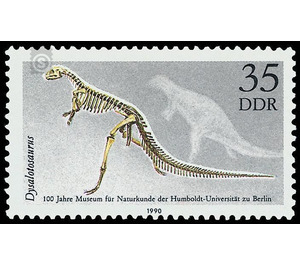100 years Museum for Naturopathy of the Humboldt University Berlin - Germany / German Democratic Republic 1990 - 35 Pfennig
Theme: Animals
| Country | Germany / German Democratic Republic |
| Issue Date | 1990 |
| Face Value | 35.00 |
| Color | grey |
| Perforation | K 13:12 1/2 |
| Printing Type | offset |
| Stamp Type | Postage stamp |
| Item Type | Stamp |
| Chronological Issue Number | 3068 |
| Chronological Chapter | GER-DDR |
| SID | 912967 |
| In 15 Wishlists | |
100 Years Museum of Natural History Berlin On the occasion of the 100th anniversary of the Museum of Natural History of the Humboldt University in Berlin, the Ministry of Posts and Telecommunications of the German Democratic Republic issues five multicolored special postage stamps and a miniature sheet. Special Stamps from April 17 to June 16, 1990 100 Years Museum of Natural History Berlin In 1890, the natural history collections of the University of Berlin, combined in the Museum of Natural History, began to make their exhibition rooms accessible to the public in the then newly constructed building. On the special postage stamp series issued for this occasion, some of the dinosaur finds from the Tendaguru strata of East Africa are shown, which also contributed to the attractiveness and the international reputation of the museum. From 1909 to 1912, an expedition of the museum was able to carry out very successful excavations, to whose finds the dinosaur skeletons depicted belong. Dinosaurs have been the dominant animal group on Earth for more than 150 million years. In the Jurassic and Cretaceous periods, their development with giant shapes reached a climax. 35-pfennig value: Dysalotosaurus lettow-vorbecki POMPECKJ, 1920 The bird foot dinosourier (ornithopods) are a group of ornithischians whose bipedal mode of locomotion made them nimble runners. The forelegs were reduced and only usable as gripping organs. The probably herdenweise living only 2.5 m long dinosaur was an herbivore. Dysalotosaurus from the African Tendaguru strata is almost identical to Dryosaurus from North American deposits of the same age.


